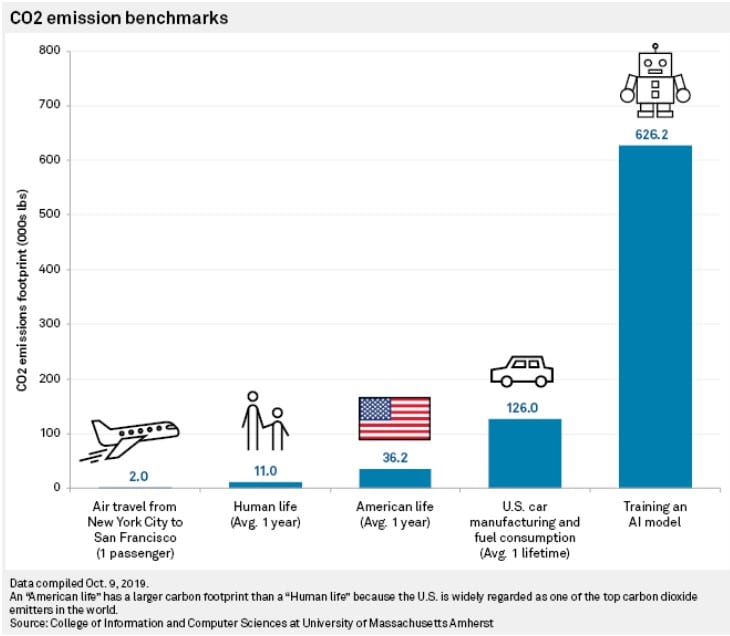As the transformative power of Artificial Intelligence (AI) continues to fuel innovation, concerns are rising about its negative impact on the environment. In this article, we delve into the environmental impact of AI, exploring associated problems including carbon emissions, electronic waste, and potential harm to ecosystems. Through proactive measures and ethical practices, we examine how society can effectively address these concerns and strive for a sustainable future where AI and environmental preservation go hand in hand.
_
Artificial Intelligence (AI) is hailed as a game-changer but beneath its transformative potential lies a pressing concern: its environmental impact. The development, maintenance, and disposal of AI technology all come with a large carbon footprint.
In this article, we dive deep into the hidden environmental dilemma surrounding AI and explore the urgent need for proactive measures. A sustainable future may be secured, and the risks AI brings to our world can be reduced by being aware of the effects and acting responsibly.
AI’s Carbon Footprint
Behind the scenes of AI’s brilliance lies an energy-intensive process with a staggering carbon footprint.
As datasets and models become more complex, the energy needed to train and run AI models becomes enormous. This increase in energy use directly affects greenhouse gas emissions, aggravating climate change. According to OpenAI researchers, since 2012, the amount of computing power required to train cutting-edge AI models has doubled every 3.4 months. By 2040, it is expected that the emissions from the Information and Communications Technology (ICT) industry as a whole will reach 14% of the global emissions, with the majority of those emissions coming from the ICT infrastructure, particularly data centres and communication networks. These data demonstrate the urgent need to address AI’s carbon footprint and role in environmental deterioration.
Recently, a study was conducted by researchers at the University of Massachusetts to determine how much energy is used to train certain popular large AI models. According to the results, training can produce about 626,000 pounds of carbon dioxide, or the equivalent of around 300 round-trip flights between New York and San Francisco – nearly 5 times the lifetime emissions of the average car.

Electronic Waste Disposal
The e-waste produced by AI technology poses a serious environmental challenge. E-waste contains hazardous chemicals, including lead, mercury, and cadmium, that can contaminate soil and water supplies and endanger both human health and the environment.
By 2050, the World Economic Forum (WEF) projects that the total amount of e-waste generated will have surpassed 120 million metric tonnes. To avoid environmental harm and minimise the release of dangerous compounds, proper e-waste management and recycling are essential. To ensure the secure processing and recycling of AI-related electronic waste and significantly reduce its negative environmental effects, more stringent laws and ethical disposal practices are required.
You might also like: What is E-Waste Recycling and How Is it Done
Impact on Natural Ecosystems
AI applications like driverless automobiles and delivery drones pose a threat to animals and natural environments. Automation fuelled by AI may result in greater consumption as well as increasing waste in certain sectors, such as the e-commerce industry, which has normalised the rapid and frequent delivery of goods.
The rising use of AI in agriculture could result in the overuse of pesticides and fertilisers, contaminating the soil and water, and harming biodiversity. Implementing AI in agricultural practices to increase yields at the expense of maintaining ecosystem health could lead to monocultures and biodiversity loss.
Using AI for environmental management also raises ethical questions. Decisions made by AI systems could be biased if they were presented with inaccurate or incomplete data. For instance, if an AI system received instructions to value economic growth over environmental protection, it might choose to put short-term financial gain ahead of environmental sustainability.
People can build sustainable practises and make educated decisions by taking into account the potential environmental effects of AI adoption. AI’s advantages must be balanced with protecting our natural ecosystems in order for technology and nature to coexist.
Lack of Transparency and Accountability
The shadowy realm of AI development and utilisation breeds a lack of transparency and accountability regarding its environmental impact. Certain companies put their financial well-being and competitive edge ahead of any potential negative effects that AI technologies may have on the environment. Users find it challenging to completely appreciate their environmental footprint due to the complexity of AI systems. Accurate evaluation of their carbon footprint or potential environmental impact is hampered by the secretive methods and hidden data used to train AI models.
To solve this, more transparent procedures and laws that ensure the creation and application of AI are in line with environmental concerns are necessary. A responsible approach to AI that prioritises sustainability will be made possible by working toward greater accountability.
Approach to Ensuring the Long-Term Viability of AI
A multifaceted strategy is needed to reduce AI’s impact on the environment.
First and foremost, energy consumption may be considerably decreased by funding the study and creation of energy-efficient hardware and AI algorithms. By optimising their hardware and algorithms, AI systems can achieve similar efficiency with less energy consumption. Promoting ethical AI design standards, including avoiding pointless data collection and making sure end-of-life considerations are taken into account, is also essential.
A culture of openness and responsibility must be promoted as well. To evaluate their environmental impact, stakeholders must prioritise providing pertinent data on AI models and data sources. To ensure the ethical creation, use, and disposal of AI technologies, governments and regulatory agencies should adopt precise standards and restrictions. Collaboration between businesses, academics, and policymakers is also essential. Researchers should create solutions that prioritise technological breakthroughs and environmental sustainability by promoting multidisciplinary research and knowledge exchange.
You might also like: 7 Data-Based & Artificial Intelligence Projects To Help Fight Climate Change
Final Thoughts
The environmental repercussions of AI’s meteoric rise are a cause for genuine concern and demand urgent attention. While the allure of AI’s potential is undeniable, we must confront its negative impact head-on.
By shedding light on the hidden environmental dilemma surrounding AI, people can foster an informed dialogue and drive the adoption of responsible practices.
What are your thoughts on AI’s potential adverse effects on ecosystems? How can society effectively address these concerns? Together, let’s shape a sustainable future where AI and environmental preservation go hand in hand.
This story is funded by readers like you
Our non-profit newsroom provides climate coverage free of charge and advertising. Your one-off or monthly donations play a crucial role in supporting our operations, expanding our reach, and maintaining our editorial independence.
About EO | Mission Statement | Impact & Reach | Write for us




















